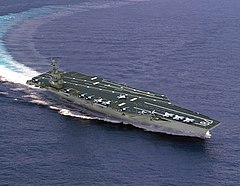USS Doris Miller (CVN-81)
| ||
 Artystyczna wizja lotniskowca typu Gerald R. Ford | ||
| Klasa | lotniskowiec | |
| Typ | Gerald R. Ford | |
| Historia | ||
| Stocznia | Newport News | |
| Zamówiony dla | ||
| Dane taktyczno-techniczne | ||
| Wyporność | 100 000 długich ton | |
| Napęd | ||
| 2 reaktory PWR, 4 wały napędowe | ||
| Prędkość | ≥ 30 węzłów | |
USS Doris Miller (CVN-81) – amerykański lotniskowiec z napędem jądrowym w planach budowy, czwarty okręt typu Gerald R. Ford. Planowana data rozpoczęcia budowy to styczeń 2026, zakończenia budowy - październik 2029, a wejścia do służby - 2030. Jednostkę przypisano do wyprodukowania w stoczni Newport News Shipbuilding w stanie Virginia. Okręt ma mieć wyporność 100 000 długich ton. Lotniskowiec zostanie nazwany na cześć Amerykanina Dorisa Millera, pierwszego czarnoskórego, któremu przyznano Krzyż Marynarki Wojennej[1].
Przypisy
- ↑ USNI News, Next Ford-class Carrier to be Named After Pearl Harbor Hero Doris Miller, USNI News, 18 stycznia 2020 [dostęp 2020-11-26] (ang.).
Media użyte na tej stronie
The flag of Navassa Island is simply the United States flag. It does not have a "local" flag or "unofficial" flag; it is an uninhabited island. The version with a profile view was based on Flags of the World and as a fictional design has no status warranting a place on any Wiki. It was made up by a random person with no connection to the island, it has never flown on the island, and it has never received any sort of recognition or validation by any authority. The person quoted on that page has no authority to bestow a flag, "unofficial" or otherwise, on the island.
Artist's concept of CVN-78, a new class of aircraft carriers. A new nuclear propulsion plant will power the next class of aircraft carriers. The new plant will require fewer operators thereby lowering life-cycle costs, and will provide increased electrical power that will be available for the demands of developing technology. Smart sensors will assist in further reducing Navy watch standing requirements and in automating damage control functions such as detecting fire and flooding situations. Flight deck redesign and a transition to an advanced aircraft recovery system (AARS) will reduce crew workload, enhance safety and reduce the costs of operating and maintaining a carrier throughout its planned 50-year life cycle.

